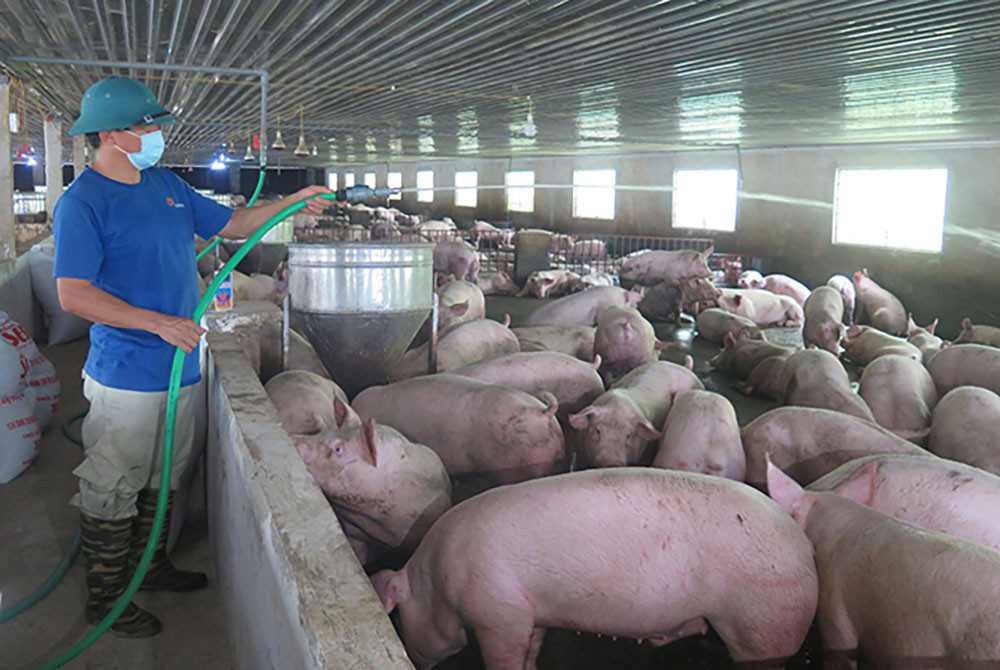
Animal husbandry plays an important role in Vietnam’s agriculture and economy. The products of the sector not only satisfy food demand of 100 million people, but also bring livelihoods to 6 million people.
However, with herds of 28-29 million pigs, 545 million poultries, 2.3 buffaloes, 6.7 millions cows, and 2.9 million goats and sheep, this is the second biggest greenhouse gas emitter in the agriculture sector.
The greenhouse gas emissions in animal husbandry come from two major sources, including methane of ruminants’ ramen and CH4 and N2O from animal feces.
According to the Ministry of Agriculture and Rural Development (MARD), the total waste of the husbandry industry reached 81.8 million tons in 2022. Of this, 44.9 percent was from pig farming, 26.7 percent from cows, 15.3 percent from buffaloes, 8.1 percent from poultry, and 4.9 percent from milk cows.
The liquid waste from livestock in 2022 was estimated at 379 million cubic meters, but only 50 percent of solid waste and 20 percent of liquid waste were treated before they were discharged into the environment.
A survey conducted in 2016 showed that greenhouse gas emissions from ruminants’ ramen accounted for the biggest proportion, 444,000 tons of CH4, or 12.42 million tons of CO2e, while emissions from animal feces included 11,000 tons of N2) (2.97 million tons of CO2e) and 112,000 tons of CH4 (3.13 million tons of CO2e).
According to the list of emitters and emission levels released to serve the greenhouse gas inventory published by the Ministry of Natural Resources and the Environment (MONRE) in late 2022, among animals that emit methane from their rumen, every milk cow emits 78 kilograms of CH4 gas a year, buffalo 76 kilograms, cows 54 kilograms, horses 18 kilograms, goats and sheep 5 kilograms, and pigs one kilogram.
Since the number of cows and buffaloes in Vietnam is high, the methane emission volume from cows is up to 250,000 tons per annum, and from buffaloes 138,000 tons and milk cows 20,000 tons.
If noting that pigs are sold when they reach 90 kilograms in weight, a pig will emit 438 kilograms of CO2 during its life. In general, every faming household sells 2 broods of pigs a year, and if every household raises 3,000 pigs, a pig farm will produce 3,000 tons of CO2 equivalent each year.
The national report on greenhouse gas emissions showed that emissions of the husbandry are increasing year after year. They totalled 18.5 million tons of CO2 equivalent in 2016 and increased to 22.2 million tons in 2018 and to 30.84 million tons in 2020.
Emissions stocktaking
MONRE, which is drafting the decree to amend Decree 06/2022 dated January 7, 2022 on greenhouse gas emission reduction and ozone layer protection, has added animal husbandry to the list of businesses subject to mandatory greenhouse gas emission stocktaking.
According to Vietnam’s Nationally Determined Contributions (NDCs), the potential of the emission reduction measures related to the animal husbandry in 2021-2030 is 152.5 million tons of CO2 equivalent, or 54 percent of total potential emissions of the agriculture sector.
Deputy Minister of Agriculture and Rural Development Phung Duc Tien stressed that greenhouse gas emission inventory and emission reductions in animal husbandry are both a must.
Nguyen Xuan Duong, chair of the Vietnam Livestock Association, said greenhouse gas emission reduction and ozone layer protection will realize Vietnam’s commitments to mitigate emissions.
However, he warned that it would be unreasonable to apply the regulation on mandatory emission stocktaking now. His association has proposed that the government not include animal husbandry onto the list of subjects to mandatory stocktaking.
Under the draft decree, the farms with 3,000 pigs or higher, or 1,000 cows or higher will have to conduct inventory. This means that 4,000 pig and cow farms will have to do this, which will cost them a lot of money.
The greenhouse gas emission stocktaking may cost each farm at least VND100-150 million a year. Meanwhile, most farms in Vietnam cannot do this themselves as the work is too complicated.
Duong said that there should be a roadmap for enterprises and farms to become familiar with the stocktaking, receive knowledge and suitable technology, improve farming conditions, and prepare resources to implement the inventory.
Tam An